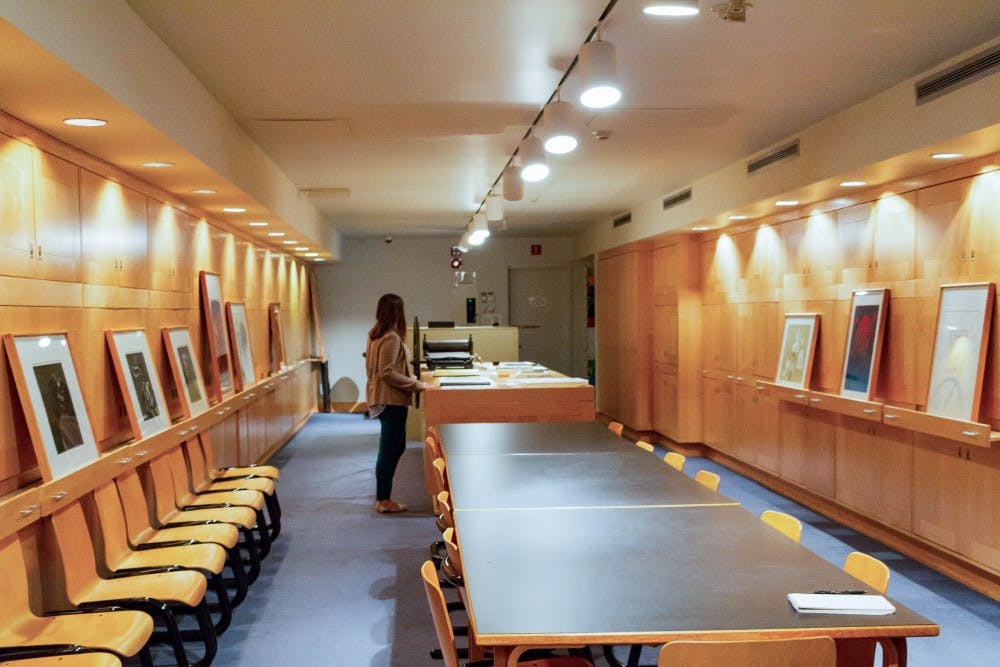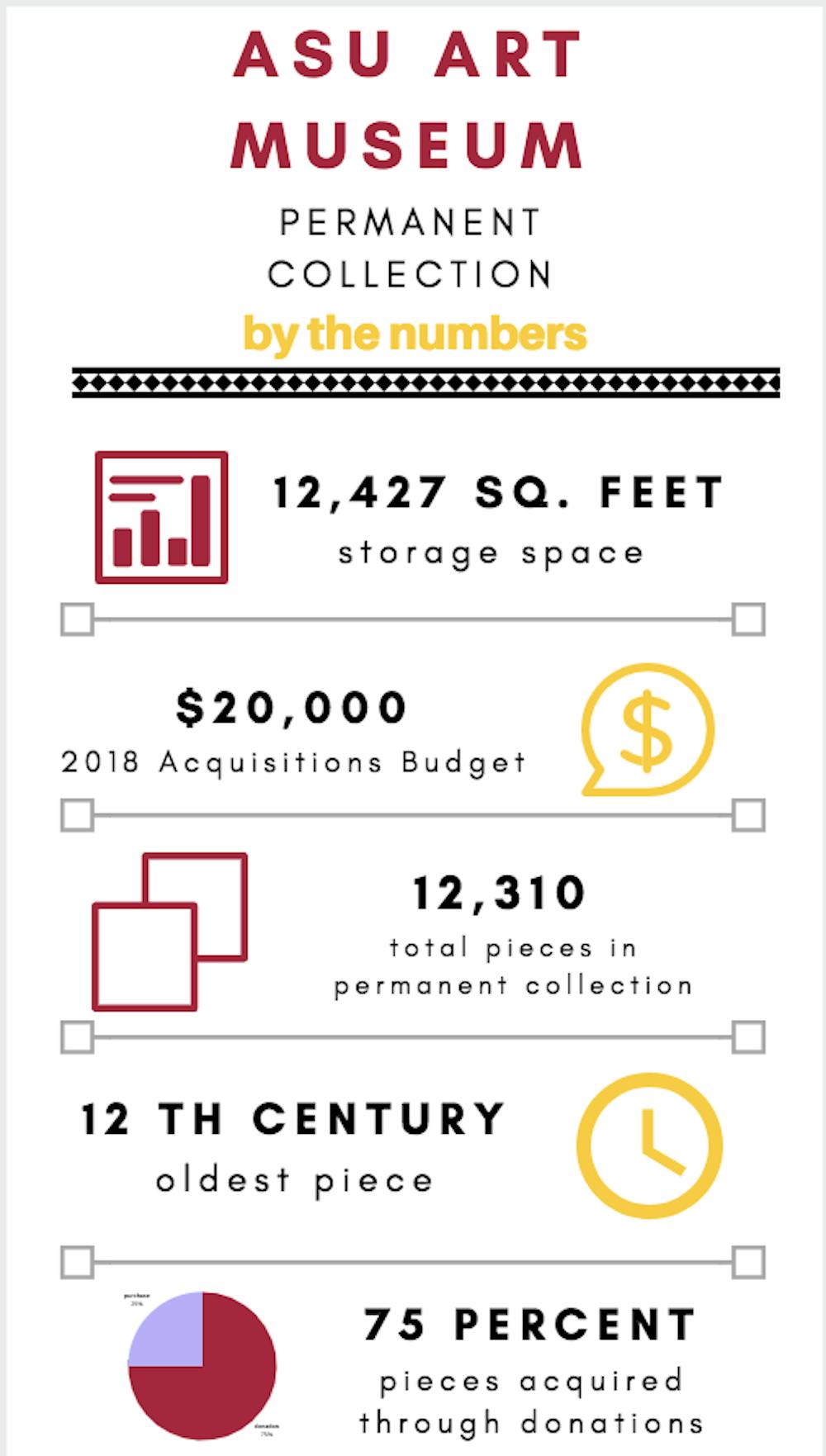Tucked underground beneath the intersection of Mill Avenue and Tenth Street is the ASU Art Museum — the permanent home of 12,310 art objects created by artists including big names like Georgia O’Keefe and Diego Rivera.
The permanent collection is an integral part of the museum, with pieces ranging from 12th century ceramics to contemporary screenprints. Once they're part of the collection, the pieces serve as cultural assets for the community with the museum assuming permanent ownership of the works.
"From a broad scope and depth of geography and chronology, the permanent collections of the ASU Art Museum include some of the most creative and compelling expressions of human creativity," said Miki Garcia, ASU Art Museum director. "We believe that the museum is the cultural anchor of the ASU community."
As a renowned university art museum, the ASU Art Museum states its mission is to be a meeting point for the exchange of ideas, perspectives and experiences for students, artists and the community. With the overall mission being realized through exhibitions and educational opportunities, the permanent collection is only one piece of the intricate institution.
While thousands of pieces have found their final home in the ASU Art Museum, Garcia said the permanent collection opens the works to a world of scholarship and research found within and outside of the University – helping bust the misconception that permanent collections are where pieces go to die because they are stored and never seen.
Growing the permanent collection
Pieces in the permanent collection are acquired through donations, collection and solicitation funds, museum store revenue and works commissioned or originated by the museum. Garcia said the acquisition process starts with community recognition.
Because the University is a state institution, the museum's permanent collection is considered a public asset that anyone from the community has the right to access. Garcia said she hopes more people approach the museum in this frame of reference.
“There needs to be a feeling of pride and ownership from the community about the assets we have at the University,” said Garcia, whose job includes working to ensure the University and community are informed about the permanent collection as important cultural assets.
The museum hosts family-oriented events, speaker series and artist residencies, and is home to multiple research initiatives to bring the community closer to the pieces in the permanent collection.
The ASU Art Museum was founded on a large donation in 1950. Oliver B. James, a well-known lawyer in the Valley, purchased many American, Mexican and European artworks, including many masterpieces. James gifted over 150 pieces from his personal collection over five years to start the ASU Art Museum.
Read More: ASU Art Museum weaves a 60-year legacy on campus
More than 9,300 pieces of the permanent collection were acquired through full donation and about 1,500 pieces have been purchased through funds donated by an organization.
Garcia said she hopes to reverse this long-standing trend by acquiring pieces directly.
"Being more transparent with the public about the complexity of the acquisition process will help the museum leverage funds to increase curatorial acquisitions," she said.
In 2018, the museum operated with a $20,000 acquisition fund.
Acquisition through budgets and endowments allows the museum to grow its collection in a way that will best complement the existing work, Garcia said. Armed with expertise on the existing collection, curators are able to search for pieces that complete existing collections or grow targeted areas.
Receiving pieces via donation, on the other hand, does not allow for the same curatorial flexibility.
The museum has an emphasis on contemporary art, post-WWII American ceramics, prints, Southwest Art, contemporary Latin American works and new methods of presentation. The print collection is the largest in the permanent collection.
Infographic by Grace Oldham
“With a larger acquisitions fund we could be more forward-looking in identifying what the future might be necessitating of our community,” Garcia said.
Dana Tepper, conservator at the ASU Art Museum, said works are also added to the permanent collection through relationships with living artists. Pieces commissioned for exhibitions are often added to the permanent collection after the exhibition.
“We find ourselves working frequently with artists on the cutting edge,” Tepper said.
The ASU Art Museum is a teaching museum, Garcia said, so when artists are invited to make a new work they are sharing their creative process with the community.
“We need to identify ourselves as a different kind of museum in the Valley,” Garcia said. “I think one of the things that differentiates ourselves is that we do have living artists in our museums a lot and we are infusing the museum with active living artists.”
A calculated exchange
With every proposed addition to the permanent collection, multiple departments in the museum conduct a close examination of the costs, storage and collection fit in owning and caring for the piece. The museum will not accept pieces if it cannot afford the resources and staff to make the piece fit with the museum’s standards for conservation and storage.
To keep track of the pieces, the works go through a museum registrar's office where they are labeled and entered into a database. The lead registrar works with curators to make a physical record for the piece which includes all of the legal documents and object information.
Alongside essential information on the artist’s name, title of the work, dimensions, medium and credit line, Tepper said she started to interview artists who are still alive about their work to get better information for conservation.
“I chat with them about everything from techniques, and fabrication methods to how interventive they would like us to be should something happen to the piece,” Tepper said. “It’s very nuanced information that needs to be recorded somewhere so that as the piece ages, we can adjust our expectations accordingly.”
Into the vaults
With all of the documents for the care and history of a piece in place, the museum then identifies an appropriate storage location.
The museum has made several moves from its original location in 1950 in the hallway, offices and lobby of Matthews Library to its current location at the Nelson Fine Arts Center. The space includes five galleries, three sculpture courts, collection management and storage space, a conservation workspace, museum store, classrooms and administrative offices.
When pieces are not on exhibit, they are in storage vaults which are located underground in the ASU Art Museum, with the vaults organized by medium.
The vaults allow the control of temperature, light, humidity and dust. While the artistic design of the building by American architect Antoine Predock provides some challenges for maneuvering around the vaults, using draped shelving and having the vaults underground helps the conservators maintain steady conditions for the pieces and also saves energy.
Life in the underground
In addition to controlled storage and detailed documentation on every piece, the ASU Art Museum has a four-year-old conservation department with an on-staff conservator.
“We are systematically going through the collection and making sure all the prints and drives are matted in materials and stored properly," Tepper said.
In the permanent collection, the pieces can be used for education, exhibition and research. Garcia said researchers from across the nation will frequently make appointments with the museum to see pieces of the collection as part of their research.
There are also occasions where artists have designed their exhibitions around a specific piece from the permanent collection. An iconic instance of this occurrence is the exhibition and research around a piece that was identified as a false attribution to the American artist Fredric Remington.
She said the exhibition about the falsely attributed Remington piece is a quintessential example of the layered and limitless possibilities for the community’s engagement with the permanent collection.
Garcia said making the collection available to the community through creative means helps the museum fulfill its mission.
“We are always making a concerted effort to illuminate the treasures that we hold and make them accessible to as large of a public as possible," she said.
Reach the reporters at goldham@asu.edu and follow @graceoldham123 on Twitter.
Like The State Press on Facebook and follow @statepress on Twitter.





